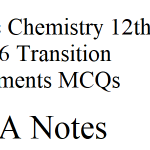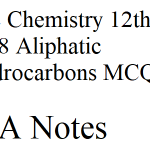FSc Chemistry 12th Ch 7 Fundamental Principles of Organic Chemistry MCQs
2nd year Chemistry Notes, Short Questions, Numericals, Multiple Choice Questions (MCQs), Long Questions
If you want to view other notes of FSc Chemistry Part 2 Please Click Here.
Exercise MCQs
Q1. Fill in the blanks:
(i) Organic compounds having same molecular formula but different structures are called isomers.
(ii) The state of hybridization of carbon atom in ethene is sp2.
(iii) Alkenes show geometrical isomerism due to restricted rotation around a carbon-carbon double bond.
(iv) Heating an organic compound in the absence of oxygen and in the presence of SiO2 + Al2O3 as catalyst is called catalytic cracking.
(v) A group of atoms which confers characteristic properties to an organic compound is called functional group.
(vi) 2-butene is positional isomer of 1-butene.
(vii) Carbonyl functional group is present in both aldehyde and ketones.
(viii) A heterocyclic compound contains an atom other than carbon in its ring.
(ix) The quality of gasoline can be checked by finding out its octane number.
(x) A carboxylic acid contains -COOH as a functional group.
Q2. Indicate True or False:
(i) There are three possıble isomers for pentane. True
(ii) Alkynes do not show the phenomenon of cis-trans isomerism. True
(iii) Organic compounds cannot be synthesized from inorganic compounds. False
(iv) All close chain compounds are aromatic in nature. False
(v) The functional group present in amides is called an amino group. False
(vi) Government of Pakistan is trying to use coal for power generation. True
(vii) Crude petroleum is subjected to fractional sublimation in order to separate it into different fractions. False
(viii) A bond between carbon and hydrogen serves as a functional group for alkanes. False
(ix) o-nitrotoluene and p-nitrotoluene are the examples of functional group isomerism. False
(x) Almost all the chemical reactions taking place in our body are inorganic in nature. False
Q3. Multiple choice questions. Encircle the correct answer:
(i) The state of hybridization of carbon atom in methane is:
- sp3
- sp2
- sp
- dsp2
(ii) In t-butyl alcohol, the tertiary carbon is bonded to:
- Two hydrogen atoms
- Three carbon atoms
- One hydrogen atom
- None of these
(iii) Which set of hybrid orbitals has planar triangular shape:
- sp3
- sp
- sp2
- dsp2
(iv) The chemist who synthesized urea from ammonium cyanate was:
- Berzelius
- Kolbe
- Wohler
- Lavoisier
(v) Linear shape is associated with which set of hybrid orbitals:
- sp
- sp2
- sp2
- dsp2
(vi) A double bond consists of:
- Two sigma bonds
- One sigma and one pi bond
- One sigma and two pi bonds
- Two pi bonds
(vii) Ethers show the phenomenon of:
- Position isomerism
- Functional group isomerism
- Metamerism
- Both (b) and (c)
(viii) Select from the following the one which is alcohol:
- CH3-CH2-OH
- CH3-O-CH3
- CH3COOH
- CH3-CH2-Br
Additional MCQs

(i) Isomerism exhibited by ethanol and dimethyl ether is:
- Position isomerism
- Metamerism
- Functional group isomerism
- Chain isomerism
(ii) Which one of the following does not show geometric isomerism:
- ClHC = CHCl
- HC – HC = CHCH3
- H2C = CHCl
- BrClC = CClBr
(iii) Concept of octane number was Introduced by:
- Kekule
- Edgar
- Wholer
- Dalton
(iv) Which of the following form of coal has maximum %age of carbon:
- Peat
- Bituminous
- Sub-bituminous
- Anthracite
(v) Which of the following is the use of light naphtha:
- Non-polar solvent
- Lubricant
- Roofing
- Polar solute
(vi) An isomer of ethanol is:
- Dimethyl ether
- Diethyl ether
- Ethylene glycol
- Methanol
(vii) Which of the following has zero dipole moment:
- 2-methyl-1-propene
- 1-butene
- Trans-2-butene
- Cis-2-butene
(viii) Fractional distillation of petroleum yields only about ___ of gasoline.
- 40%
- 20%
- 70%
- 10%
(ix) The octane number is 100% in petroleum:
- Neo-octane
- n-Hexane
- Neo-pentane
- Iso-octane
(x) Which one is the functional group of esters:
- -(C=O)-X
- -(C=O)-OH
- -(C=O)-OR
- -(C=O)-H
(xi) Carbon atom of HCHO (methanal, formaldehyde) is:
- sp hybridized
- sp2 hybridized
- sp3 hybridized
- Not hybridized
(xii) Alkanoic acid is another name of:
- Aldehyde
- Ketones
- Carboxylic acid
- Alcohols
(xiii) Which of the following compounds will exhibit cis-trans (isomerism):
- Butanal
- 2-butyne
- 2-butanol
- 2-butene
(xiv) The reaction C8H18 –Δ→ C3H6 + Fragments is:
- Catalytic oxidation
- Isomerization
- Synthesis
- Cracking






